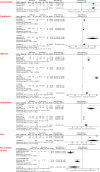Gut Microbiota Alteration is Characterized by a Proteobacteria and Fusobacteria Bloom in Kwashiorkor and a Bacteroidetes Paucity in Marasmus
- PMID: 31235833
- PMCID: PMC6591176
- DOI: 10.1038/s41598-019-45611-3
Gut Microbiota Alteration is Characterized by a Proteobacteria and Fusobacteria Bloom in Kwashiorkor and a Bacteroidetes Paucity in Marasmus
Retraction in
-
Retraction Note: Gut Microbiota Alteration is Characterized by a Proteobacteria and Fusobacteria Bloom in Kwashiorkor and a Bacteroidetes Paucity in Marasmus.Sci Rep. 2023 Oct 30;13(1):18590. doi: 10.1038/s41598-023-44593-7. Sci Rep. 2023. PMID: 37903834 Free PMC article. No abstract available.
Abstract
Kwashiorkor and marasmus are considered to be two different clinical diseases resulting from severe malnutrition, but this distinction has been questioned. In a previous study comparing children with kwashiorkor and healthy children from Niger and Senegal, we found a dramatic gut microbiota alteration with a predominant depletion of anaerobes and enrichment in Proteobacteria and Fusobacteria in kwashiorkor. However, it remained unknown whether this association was related to malnutrition or was a specific feature of kwashiorkor. In this continuation study, we added 7 new marasmus subjects and 71,162 new colonies from the same countries. Our results showed that, compared to marasmus, the kwashiorkor gut microbiota was characterized by an increased proportion of Proteobacteria (culturomics, Marasmus 5.0%, Kwashiorkor 16.7%, p < 0.0001; metagenomics, Marasmus 14.7%, Kwashiorkor 22.0%, p = 0.001), but there was a decreased proportion of Bacteroidetes in marasmus (culturomics, Marasmus 0.8%, Kwashiorkor 6.5%, p = 0.001; metagenomics, Marasmus 5.4%, Kwashiorkor 7.0%, p = 0.03). Fusobacterium was more frequently cultured from kwashiorkor. All detected potential pathogenic species were enriched in the kwashiorkor gut microbiota. These results provide a biological basis to support the usage of an antibiotic therapy more effective in suppressing the overgrowth of bacterial communities resistant to penicillin, combined with antioxidants and probiotics for nutritional recovery therapies, particularly for kwashiorkor.
Conflict of interest statement
The authors declare no competing interests.
Figures






Similar articles
-
Difference between kwashiorkor and marasmus: Comparative meta-analysis of pathogenic characteristics and implications for treatment.Microb Pathog. 2021 Jan;150:104702. doi: 10.1016/j.micpath.2020.104702. Epub 2021 Jan 3. Microb Pathog. 2021. PMID: 33359074 Review.
-
Retraction Note: Gut Microbiota Alteration is Characterized by a Proteobacteria and Fusobacteria Bloom in Kwashiorkor and a Bacteroidetes Paucity in Marasmus.Sci Rep. 2023 Oct 30;13(1):18590. doi: 10.1038/s41598-023-44593-7. Sci Rep. 2023. PMID: 37903834 Free PMC article. No abstract available.
-
Gut Bacteria Missing in Severe Acute Malnutrition, Can We Identify Potential Probiotics by Culturomics?Front Microbiol. 2017 May 23;8:899. doi: 10.3389/fmicb.2017.00899. eCollection 2017. Front Microbiol. 2017. PMID: 28588566 Free PMC article.
-
[Vitamin e supplementation in Senegalese children with kwashiorkor].Sante. 1996 Jul-Aug;6(4):209-12. Sante. 1996. PMID: 9026318 Clinical Trial. French.
-
Gut microbiota and malnutrition.Microb Pathog. 2017 May;106:127-138. doi: 10.1016/j.micpath.2016.02.003. Epub 2016 Feb 4. Microb Pathog. 2017. PMID: 26853753 Review.
Cited by
-
Gut dysbiosis: Ecological causes and causative effects on human disease.Proc Natl Acad Sci U S A. 2023 Dec 12;120(50):e2316579120. doi: 10.1073/pnas.2316579120. Epub 2023 Dec 4. Proc Natl Acad Sci U S A. 2023. PMID: 38048456 Free PMC article.
-
The combination of berberine and evodiamine ameliorates high-fat diet-induced non-alcoholic fatty liver disease associated with modulation of gut microbiota in rats.Braz J Med Biol Res. 2022 May 16;55:e12096. doi: 10.1590/1414-431X2022e12096. eCollection 2022. Braz J Med Biol Res. 2022. PMID: 35584453 Free PMC article.
-
Gut Bacterial Composition and Functional Potential of Tibetan Pigs Under Semi-Grazing.Front Microbiol. 2022 Apr 7;13:850687. doi: 10.3389/fmicb.2022.850687. eCollection 2022. Front Microbiol. 2022. PMID: 35464912 Free PMC article.
-
Toward a Symbiotic Perspective on Public Health: Recognizing the Ambivalence of Microbes in the Anthropocene.Microorganisms. 2020 May 16;8(5):746. doi: 10.3390/microorganisms8050746. Microorganisms. 2020. PMID: 32429344 Free PMC article.
-
Modifying gut integrity and microbiome in children with severe acute malnutrition using legume-based feeds (MIMBLE): A pilot trial.Cell Rep Med. 2021 May 18;2(5):100280. doi: 10.1016/j.xcrm.2021.100280. eCollection 2021 May 18. Cell Rep Med. 2021. PMID: 34095882 Free PMC article.
References
-
- WHO | UNICEF-WHO-The World Bank Group: Joint child malnutrition estimates - levels and trends in child malnutrition. WHO Available at, http://www.who.int/nutrition/publications/jointchildmalnutrition_2017_es...(Accessed: 20th February 2018).
-
- WHO | WHO child growth standards and the identification of severe acute malnutrition in infants and children. Available at, http://www.who.int/nutrition/publications/severemalnutrition/97892415981... 18th October 2018). - PubMed
Publication types
MeSH terms
LinkOut - more resources
Full Text Sources

